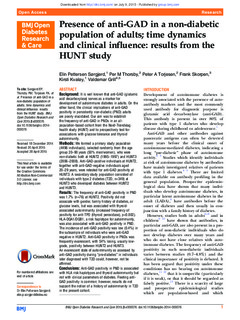Presence of anti-GAD in a non-diabetic population of adults; time dynamics and clinical influence: results from the HUNT study
| dc.contributor.author | Sørgjerd, Elin Pettersen | |
| dc.contributor.author | Thorsby, Per Medbøe | |
| dc.contributor.author | Torjesen, Peter A | |
| dc.contributor.author | Skorpen, Frank | |
| dc.contributor.author | Kvaløy, Kirsti | |
| dc.contributor.author | Grill, Valdemar Erik Robert | |
| dc.date.accessioned | 2015-07-09T12:41:22Z | |
| dc.date.accessioned | 2015-07-15T07:05:02Z | |
| dc.date.available | 2015-07-09T12:41:22Z | |
| dc.date.available | 2015-07-15T07:05:02Z | |
| dc.date.issued | 2015 | |
| dc.identifier.citation | BMJ Open Diabetes Research & Care 2015, 3 | nb_NO |
| dc.identifier.issn | 2052-4897 | |
| dc.identifier.uri | http://hdl.handle.net/11250/293185 | |
| dc.description | - Published article | nb_NO |
| dc.description.abstract | Background It is well known that anti-GAD (glutamic acid decarboxylase) serves as a marker for development of autoimmune diabetes in adults. On the other hand, the clinical implications of anti-GAD positivity in persistently non-diabetic (PND) adults are poorly elucidated. Our aim was to establish the frequency of anti-GAD in PNDs in an all-population-based cohort from the Nord-Trøndelag health study (HUNT) and to prospectively test for associations with glucose tolerance and thyroid autoimmunity. Methods We formed a primary study population (4496 individuals), selected randomly from the age group 20–90 years (50% men/women), who were non-diabetic both at HUNT2 (1995–1997) and HUNT3 (2006–2008). Anti-GAD-positive individuals at HUNT2, together with anti-GAD-negative individuals aged 20–29 years, were retested for anti-GAD positivity at HUNT3. A secondary study population consisted of individuals with type 2 diabetes (T2D, n=349) at HUNT3 who developed diabetes between HUNT2 and HUNT3. Results The frequency of anti-GAD positivity in PND was 1.7% (n=76) at HUNT2. Positivity did not associate with gender, family history of diabetes, or glucose levels, but was associated with thyroid-associated autoimmunity (increased frequency of positivity for anti-TPO (thyroid peroxidase), p<0.002). HLA-DQA1/DQB1, a risk haplotype for autoimmunity, was also associated with anti-GAD positivity in PND. The incidence of anti-GAD positivity was low (0.4%) in the subsample of individuals who were anti-GAD negative in HUNT2. Anti-GAD positivity in PNDs was frequently evanescent, with 54% losing, usually low-grade, positivity between HUNT2 and HUNT3. An evanescent state of autoimmunity as assessed by anti-GAD positivity during “pre-diabetes” in individuals later diagnosed with T2D could, however, not be affirmed. Conclusions Anti-GAD positivity in PND is associated with HLA risk haplotypes and thyroid autoimmunity but not with clinical parameters of diabetes. Fleeting anti-GAD positivity is common; however, results do not support the notion of a history of autoimmunity in T2D in the present cohort. | nb_NO |
| dc.language.iso | eng | nb_NO |
| dc.publisher | BMJ Publishing Group | nb_NO |
| dc.rights | This is an Open Access article distributed in accordance with the Creative Commons Attribution Non Commercial (CC BY-NC 4.0) license, which permits others to distribute, remix, adapt, build upon this work non-commercially, and license their derivative works on different terms, provided the original work is properly cited and the use is non-commercial. | |
| dc.rights.uri | http://creativecommons.org/licenses/by-nc/4.0/ | |
| dc.title | Presence of anti-GAD in a non-diabetic population of adults; time dynamics and clinical influence: results from the HUNT study | nb_NO |
| dc.type | Peer reviewed | en_GB |
| dc.type | Journal article | nb_NO |
| dc.date.updated | 2015-07-09T12:41:22Z | |
| dc.source.volume | 3 | nb_NO |
| dc.source.journal | BMJ Open Diabetes Research and Care | nb_NO |
| dc.identifier.doi | 10.1136/bmjdrc-2014-000076 | |
| dc.identifier.cristin | 1253040 | |
| dc.description.localcode | CC BY-NC 4.0 | nb_NO |
Files in this item
This item appears in the following Collection(s)
Except where otherwise noted, this item's license is described as This is an Open Access article distributed in accordance with the Creative Commons Attribution Non Commercial (CC BY-NC 4.0) license, which permits others to distribute, remix, adapt, build upon this work non-commercially, and license their derivative works on different terms, provided the original work is properly cited and the use is non-commercial.

